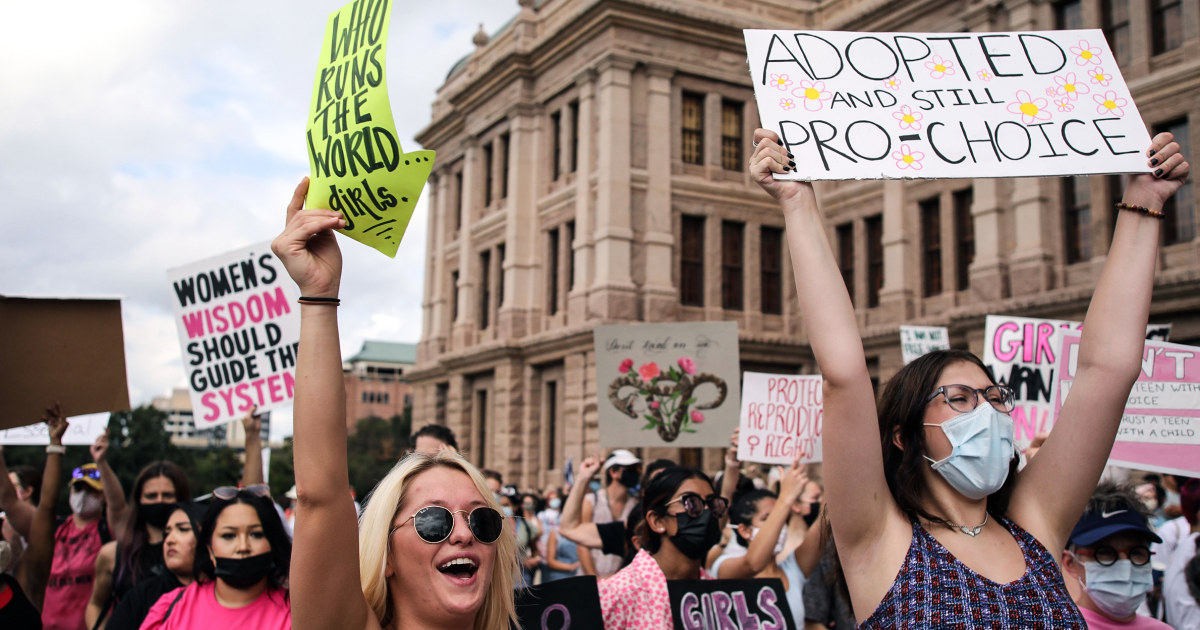
With a staff of three, the Choice Network adoption agency in Columbus, Ohio, has diligently been working to raise money over the last few months to boost its visibility and fortify its services in anticipation of Ohio’s immediate ban on abortion if Roe v. Wade, the landmark ruling guaranteeing reproductive freedom, gets overturned.
The agency, which also offers all-options counseling — including on abortion and parenting — anticipates an influx of women once that happens.
Choice Network largely relies on fees paid by adoptive families to fund its operations, but Molly Thomas, the agency’s founder, said the agency doesn’t want to “build on their backs.” She is now looking to private donors from pro-abortion rights and LGBTQ+ communities for funding to help increase staff and beef up counseling and parenting programs. The agency currently serves about 300 women and facilitates around 20 adoptions per year.
“If things go dark in Ohio, we need to be ready so women can find us,” Thomas said.
With the Supreme Court seemingly poised to overturn Roe v. Wade this year, adoption agencies around the country are now strategizing their next steps — including securing additional funding and hiring staff — should the reversal lead to higher demand for adoption services. At the same time, some experts are warning that the highly unregulated industry also should guard against a rise in “coercive adoptions” and improper vetting of adoption workers.
In the decades since Roe, the percentage of children who have been put up for adoption has declined. According to the Centers for Disease Control and Prevention, about nine percent of children born to never-married women under 45 were put up for adoption before abortion was legalized in 1973. That number dropped to 2 percent in the 1980s and fell even further — to 1 percent — in 2002, the last year for which data is available.
Private domestic adoptions are estimated to be about 0.5 percent of the annual number of births, or about 18,300 to 20,000 adoptions per year, according to a study by Gretchen Sisson, who used data from the National Council for Adoption, CDC and Guttmacher Institute to analyze patterns from 2002 to 2014. The share of adoptions could jump up significantly in a post-Roe world, perhaps even reaching pre-Roe levels, said Sisson, a sociologist at the University of California San Francisco whose research focus includes pregnancy decision-making.
Sisson said such a jump, a 20-fold increase from the current rate, would be “astronomical.”
The Open Adoption and Family Services agency in Portland, Oregon, is having talks about its next steps with respect to funding and staffing.
“We expect that we’ll see an increased need in people just generally trying to access reproductive health care, period,” said Melissa Busch, a board member for the nonprofit agency. “For some people that may translate to adoption, even though we know right now it is a pretty rare choice for people to make.” The agency is now pursuing more grants and private funding in order to strengthen its services because there will be an increased demand on staff, which does not charge for counseling, she said.
“There will be an increase in the workload, which our staff is prepared to do, because it’s part of our mission, but funding is always crucial,” she said.
Not all adoption agencies will struggle to find funding, however.
Sisson, who has extensively researched the adoption system, said the much of the adoption industry, which is dominated by religious and anti-abortion adoption agencies, may be able to scale up quickly because of the number of prospective adoptive parents in waiting.
But as they do so, she said, it could raise concerns about coercive adoptions that have long hurt birth mothers.
“I’m not worried about the private adoption system’s ability to absorb an increased number of infants being relinquished, I have more concerns for what the impact on those children and their families of origin will be long term,” Sisson said.
There is a high level of investment put into steering people toward relinquishing their parental rights and a relatively low level of support for adopted people and birth mothers over their life course, she said. The adoption industry is not highly regulated and open adoption agreements are rarely enforceable, which could translate into birth mothers becoming powerless, she said.
Busch, who put a child into an open adoption when she was 15, said her experience as a birth mother showed her how many adoption agencies can exert pressure on women to have a baby and walk away. Agencies that are all-option, that counsel pregnant women about a variety options, including abortion and adoption, need to strengthen and become more visible now, she said.
“As an agency, our goal is not to increase the amount of adoption services, our goal is to provide noncoercive care to anyone seeking decision making and assistance in terms of counseling and access to resources.”
Another concern, said Doris Houston, the director of the Center for Adoption Studies and an associate professor of social work at Illinois State University, is that adoption agencies that closed or significantly cut back as adoptions declined over the last decade will build back too quickly and with little regulation.
During the adoption process, case workers from agencies conduct home background studies with multiple home visits to make sure there are no red flags, she said. “Current agencies who have not been engaged in adoptions because there have been fewer of them may start building up their capacity so we want to make sure that those agencies are hiring trained, educated professionals,” she said. Houston worries that some agencies that may be looking to cut costs could choose entry level or improperly trained workers to conduct some of this crucial background work.
“It can get very complex and agencies need to ensure that birth parents are not signing over their rights due to pressure,” she said.
Of the pregnant 400 women who visit the Adoptions Together agency in Maryland each year on average, about 25 choose adoption, said Janice Goldwater, the agency’s chief executive officer. The agency serves Maryland, Washington D.C, and Virginia and supports reproductive freedom.
Goldwater does not think there will be a spike in people coming to the agency, but said that it will be ready and responsive if that happens. Goldwater said the agency has a broad funding base to scale up, which includes state level support from Maryland.
For Goldwater, the bigger concern is the exploitation of birth parents as adoption agencies may start taking center stage in the time after the Supreme Court makes its decision on abortion rights.
“That’s what we need to keep an eye on now.”
“The personal agenda of the organization is really critical,” she said. “The focus should be to find parents for children, as compared to finding children for parents.”
Source: | This article originally belongs to Nbcnews.com










